Space 2019: manned spacecraft, new missiles and lunar probes
Space 2019 has already begun quite vigorously - the Chinese Chang'e-4 successfully sat on the far side of the Moon, and the NASA interplanetary station New Horizons flew past the transneptunar asteroid (486958) 2014 MU 69 , making it the most distant object visited by Earth vehicles. Nevertheless, the main focus of the year lies in the field of manned spacecraft - the first flights are preparing to make Dragon 2 from SpaceX and Starliner from Boeing, and the suborbital New Shepard and SpaceShipTwo will finally have to reach 100 km with people on board. But besides this there will be a lot of interesting things.

Starliner and Dragon 2, docked to the ISS. Nathan Koga / NSF Graphics
Space projects last for years, so now the work has actually already entered the final phase - the launch facilities are improved, the crews are selected and trained, and the ships pass the final checks. In the fresh video from NASA you can see how this happens.
Boeing and SpaceX are literally nose to nose, but the latter are a bit ahead. At the same time, the dates continue to move to the right - only recently, the first unmanned launch of the Dragon SpX-DM1 was expected on January 7, then 17, and from the Mask tweet on January 4 it follows that the date has moved to February without a clear indication of the day. The main reason is the partial shutdown of the US government, due to which> 90% of the employees working on the launch are sent on leave without pay. Nevertheless, on January 6, a rocket with an installed ship was taken out and installed on the launch pad.
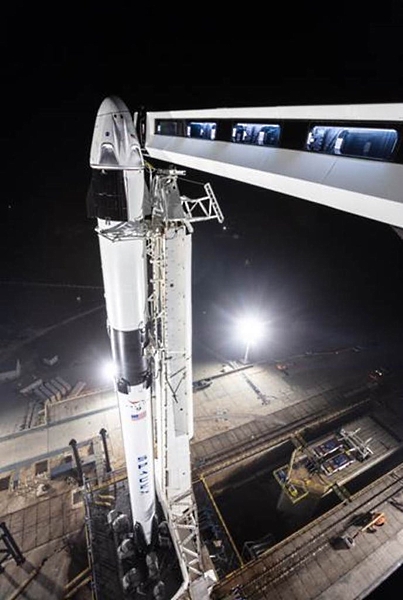
Source
The first unmanned Starliner flight is scheduled for March. In the latest news from the end of November, Boeing announced that the ship had begun final testing.
It is curious that the descriptions of missions are still known only in general terms. Both ships will go to the ISS, dock with it, spend some time in orbit and make a soft landing. Obviously, both Boeing, and SpaceX, and NASA prefer to give us surprises. The manned missions are scheduled for June (Dragon 2) and August (Starliner), but with so many transfers, you can’t seriously hope that they don’t move.
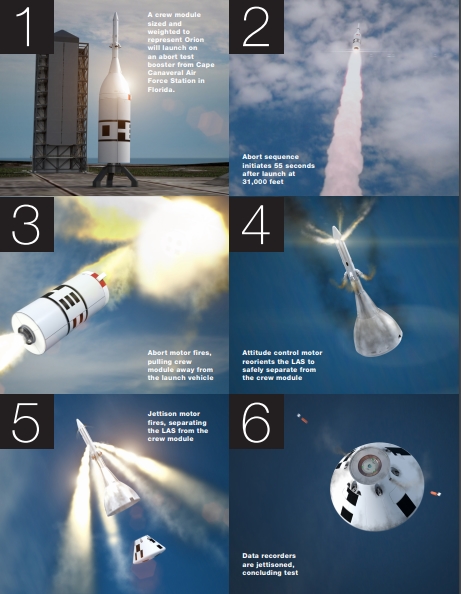
CAC Orion Test Plan, NASA Illustrations
Even Orion, whose unmanned flyby around the moon is scheduled for 2020, will have an interesting challenge this year. In April, a test of the emergency rescue in-flight system is scheduled - the ship’s model with the SAS will be installed on a ballistic missile stage, launched, diverted from the operating stage on the CAC engines, dumped modules with recorded flight parameters, and ... everything - the model is not equipped with parachutes and crashed.
In other countries, work is also underway on manned ships. In the second half of the year, tests of the new generation of Chinese ships are expected. There is little known about him so far, but in 2016, at the first test launch of the “Great March 5”, his scale model was tested.

Shot from CCTV report, 2016
The Indian manned spacecraft is expected to be in 2022, and it had tests of the SAS in the summer of 2018. The Russian Federation would go into space not earlier than 2024, the most recent news is the test of opening the landing pillars last fall.
Several light launch vehicles developed by private space companies should fly this year. Chronologically, Vector-R should be the first, its launch is scheduled for January.
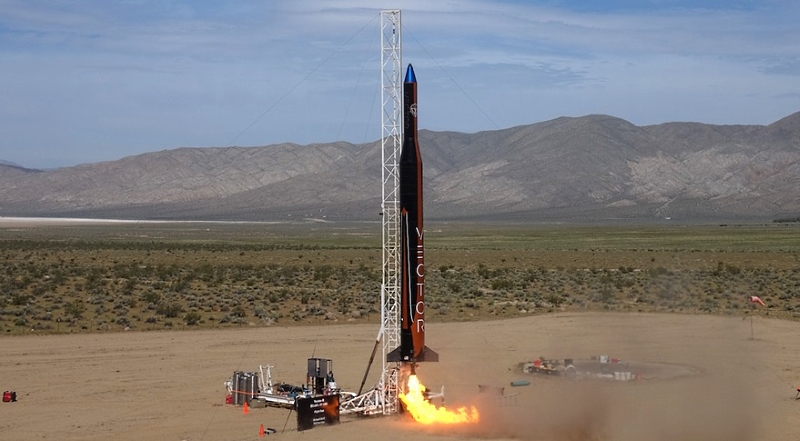
Photo: Vector
The photo is a simplified version of Vector-R in 2017. Then they made two suborbital flights. The standard version is distinguished by three engines in the first stage instead of one and is capable of putting 60 kg into low earth orbit. This is not as small as it might seem - Kubsat can be loaded in dozens. The creator company is simply bursting with optimism - in 2017 they talked about the intention to launch a hundred rockets a year.
On November 18, 2018, a test flight of a modified Boeing 747 with a suspended LauncherOne rocket took place, and the first launch is expected in the first quarter of 2019. The rocket is made in the air launch paradigm and will have to output 300-500 kg depending on the height and inclination of the orbit.
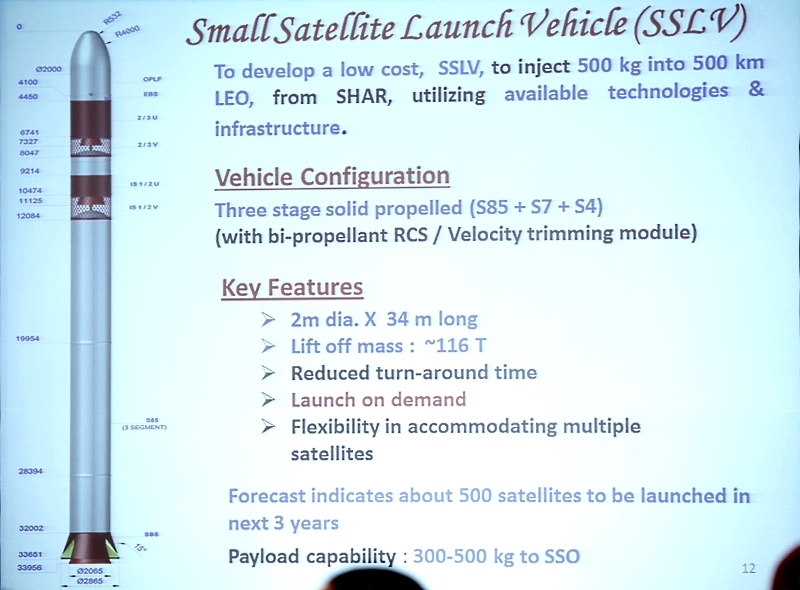
Source
India SSLV should fly in May and is different mainly in that it was created by the state space agency of India, and not by a private company. This is a three-stage solid-fuel rocket, which can take 300-500 kg to a low orbit.
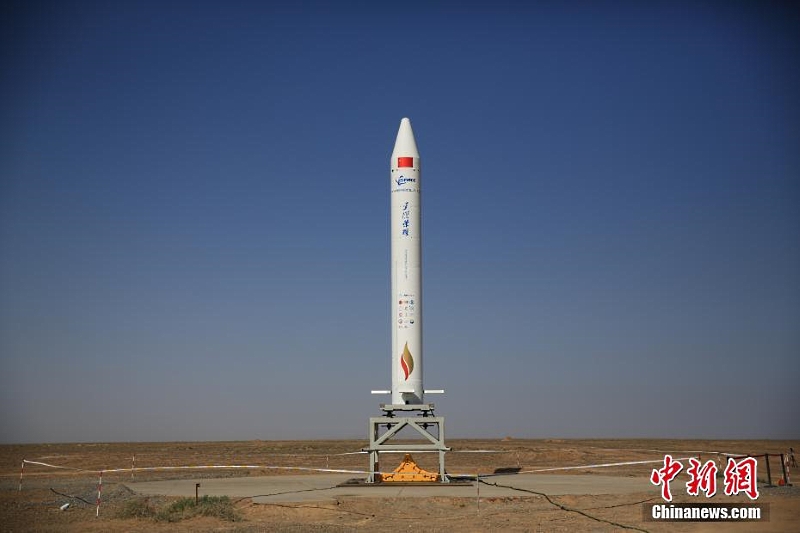
Hyperbola-1 suborbital version (SQX-1), autumn 2018
In June, Hyperbola-1 of the Chinese private space company i-Space should fly. Suborbital test launch conductedthis fall, the orbital version will have to output around 300 kg.
In a more distant future, the first flights of Firefly Alpha and Bloostar are possible, but this is no longer guaranteed.
Also here is the development of already flying rockets - the Vega of the European Space Agency will make the first flight in the Vega-C modification, and the Chinese Kuaizhou will fly in a heavier version of the Kuaizhou 11 (1.5 tons in low orbit instead of 300 kg in version 1A).
Well, we must not forget about the test bench BFR SpaceX, which is now in the process of assembling and can make the first flights this year.
Another facet of the beginning of the year - increased attention to the moon. In addition to Chang'e-4, which I hope will please us with fresh photos for a long time, several missions will fly to it.

Beresheet in the workshop, Photo SpaceIL
Already on February 13, the Indonesian communications satellite PSN-6 will go to geostationary orbit. And along with it, the first Israeli lunar landing gear Beresheet will fly (“In the beginning”, the first word of the Torah, the Old Testament and the Bible as a whole). The device will independently switch to a super-synchronous orbit, gradually raising the apocenter (upper point) will move into the zone of gravity of the Moon, enter the lunar orbit and hopefully make a soft landing in the Sea of Clarity. In general, the flight will take about 3 months. Most of the 585-kg mass of the apparatus is fuel, and of the scientific instruments on it are the Weizmann Institute Magnetometer and the reflector for laser beams from NASA. A magnetic anomaly was detected near the landing site, so the mission should have a quite serious scientific result.
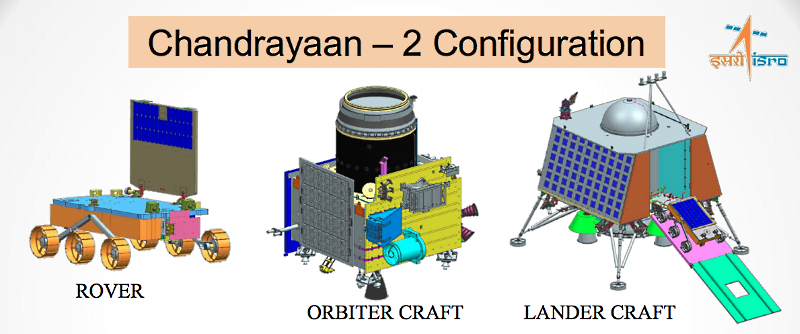
Chandrayan-2 devices, ISRO image
From January-February, Chandrayaan-2, an integrated mission of the Indian space agency with an orbiter and a landing gear with a lunar rover, moved out in April. The orbiter weighing about 2.3 tons will carry a camera for photographing the surface in high resolution and four scientific instruments. The main task of the landing gear weighing 1.4 tons is a soft landing, science is at least there, and it will work on the surface for only 15 days. The rover weighs around 27 kg and runs on solar batteries, so it can also not survive the moonlit night (or become a zombie , like a Chinese).

Possible view "Chang'e-5", image CAST
For 2019, without specifying the date, which may mean both excessive secrecy and delays in the readiness of the device, the Chinese Chang'e-5 is scheduled, which will have to bring samples of lunar soil for the first time after the Soviet Luna-24.

ALINA landing gear, PTScientists image
The official PTScientists website in the December news reports that the launch date of the ALINA private spacecraft is still 2019, but they, alas, do not have any reports with tests and photographs of real iron. So it is quite possible that an interesting idea to send rovers to take pictures of how the Apollo 17 landing site looks like 47 years later, alas, may not start this year.
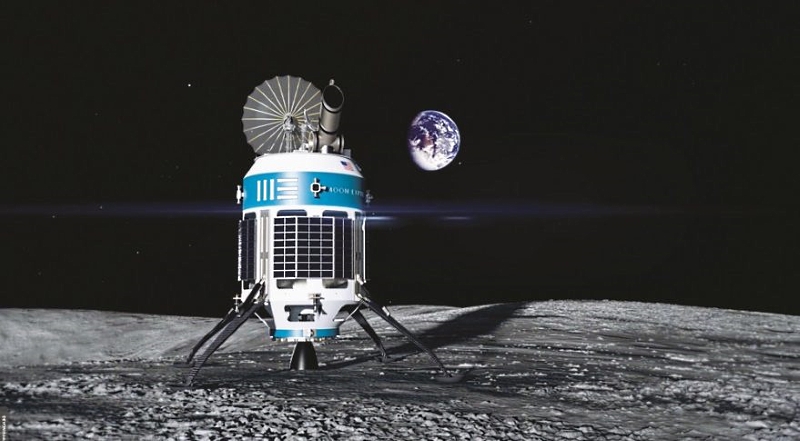
Moon Express image
Well, the least likely have to call a private landing machine Moon Express MX-1 - the latest news on the official website - the opening of the Canadian branch. This is certainly good, but there are unfortunately no specific dates and signs of active work there.
In April, the Spektr-RG gamma and X-ray observatory should go into space, which will be a big event in the Russian space program because the previous Spektr-R unit flew back in 2011.
From scientific cosmonautics it is still worth noting that in December the Japanese Hayabusa-2 probe will finish work on Ryugu asteroid and go back. Samples of the asteroid will have to return to Earth at the end of 2020, but this year should be very interesting.

Starliner and Dragon 2, docked to the ISS. Nathan Koga / NSF Graphics
Orbital ships
Space projects last for years, so now the work has actually already entered the final phase - the launch facilities are improved, the crews are selected and trained, and the ships pass the final checks. In the fresh video from NASA you can see how this happens.
Boeing and SpaceX are literally nose to nose, but the latter are a bit ahead. At the same time, the dates continue to move to the right - only recently, the first unmanned launch of the Dragon SpX-DM1 was expected on January 7, then 17, and from the Mask tweet on January 4 it follows that the date has moved to February without a clear indication of the day. The main reason is the partial shutdown of the US government, due to which> 90% of the employees working on the launch are sent on leave without pay. Nevertheless, on January 6, a rocket with an installed ship was taken out and installed on the launch pad.

Source
The first unmanned Starliner flight is scheduled for March. In the latest news from the end of November, Boeing announced that the ship had begun final testing.
It is curious that the descriptions of missions are still known only in general terms. Both ships will go to the ISS, dock with it, spend some time in orbit and make a soft landing. Obviously, both Boeing, and SpaceX, and NASA prefer to give us surprises. The manned missions are scheduled for June (Dragon 2) and August (Starliner), but with so many transfers, you can’t seriously hope that they don’t move.

CAC Orion Test Plan, NASA Illustrations
Even Orion, whose unmanned flyby around the moon is scheduled for 2020, will have an interesting challenge this year. In April, a test of the emergency rescue in-flight system is scheduled - the ship’s model with the SAS will be installed on a ballistic missile stage, launched, diverted from the operating stage on the CAC engines, dumped modules with recorded flight parameters, and ... everything - the model is not equipped with parachutes and crashed.
In other countries, work is also underway on manned ships. In the second half of the year, tests of the new generation of Chinese ships are expected. There is little known about him so far, but in 2016, at the first test launch of the “Great March 5”, his scale model was tested.

Shot from CCTV report, 2016
The Indian manned spacecraft is expected to be in 2022, and it had tests of the SAS in the summer of 2018. The Russian Federation would go into space not earlier than 2024, the most recent news is the test of opening the landing pillars last fall.
Light missile attack
Several light launch vehicles developed by private space companies should fly this year. Chronologically, Vector-R should be the first, its launch is scheduled for January.

Photo: Vector
The photo is a simplified version of Vector-R in 2017. Then they made two suborbital flights. The standard version is distinguished by three engines in the first stage instead of one and is capable of putting 60 kg into low earth orbit. This is not as small as it might seem - Kubsat can be loaded in dozens. The creator company is simply bursting with optimism - in 2017 they talked about the intention to launch a hundred rockets a year.
On November 18, 2018, a test flight of a modified Boeing 747 with a suspended LauncherOne rocket took place, and the first launch is expected in the first quarter of 2019. The rocket is made in the air launch paradigm and will have to output 300-500 kg depending on the height and inclination of the orbit.

Source
India SSLV should fly in May and is different mainly in that it was created by the state space agency of India, and not by a private company. This is a three-stage solid-fuel rocket, which can take 300-500 kg to a low orbit.

Hyperbola-1 suborbital version (SQX-1), autumn 2018
In June, Hyperbola-1 of the Chinese private space company i-Space should fly. Suborbital test launch conductedthis fall, the orbital version will have to output around 300 kg.
In a more distant future, the first flights of Firefly Alpha and Bloostar are possible, but this is no longer guaranteed.
Also here is the development of already flying rockets - the Vega of the European Space Agency will make the first flight in the Vega-C modification, and the Chinese Kuaizhou will fly in a heavier version of the Kuaizhou 11 (1.5 tons in low orbit instead of 300 kg in version 1A).
Well, we must not forget about the test bench BFR SpaceX, which is now in the process of assembling and can make the first flights this year.
Moon visits
Another facet of the beginning of the year - increased attention to the moon. In addition to Chang'e-4, which I hope will please us with fresh photos for a long time, several missions will fly to it.

Beresheet in the workshop, Photo SpaceIL
Already on February 13, the Indonesian communications satellite PSN-6 will go to geostationary orbit. And along with it, the first Israeli lunar landing gear Beresheet will fly (“In the beginning”, the first word of the Torah, the Old Testament and the Bible as a whole). The device will independently switch to a super-synchronous orbit, gradually raising the apocenter (upper point) will move into the zone of gravity of the Moon, enter the lunar orbit and hopefully make a soft landing in the Sea of Clarity. In general, the flight will take about 3 months. Most of the 585-kg mass of the apparatus is fuel, and of the scientific instruments on it are the Weizmann Institute Magnetometer and the reflector for laser beams from NASA. A magnetic anomaly was detected near the landing site, so the mission should have a quite serious scientific result.

Chandrayan-2 devices, ISRO image
From January-February, Chandrayaan-2, an integrated mission of the Indian space agency with an orbiter and a landing gear with a lunar rover, moved out in April. The orbiter weighing about 2.3 tons will carry a camera for photographing the surface in high resolution and four scientific instruments. The main task of the landing gear weighing 1.4 tons is a soft landing, science is at least there, and it will work on the surface for only 15 days. The rover weighs around 27 kg and runs on solar batteries, so it can also not survive the moonlit night (or become a zombie , like a Chinese).

Possible view "Chang'e-5", image CAST
For 2019, without specifying the date, which may mean both excessive secrecy and delays in the readiness of the device, the Chinese Chang'e-5 is scheduled, which will have to bring samples of lunar soil for the first time after the Soviet Luna-24.

ALINA landing gear, PTScientists image
The official PTScientists website in the December news reports that the launch date of the ALINA private spacecraft is still 2019, but they, alas, do not have any reports with tests and photographs of real iron. So it is quite possible that an interesting idea to send rovers to take pictures of how the Apollo 17 landing site looks like 47 years later, alas, may not start this year.

Moon Express image
Well, the least likely have to call a private landing machine Moon Express MX-1 - the latest news on the official website - the opening of the Canadian branch. This is certainly good, but there are unfortunately no specific dates and signs of active work there.
Conclusion
In April, the Spektr-RG gamma and X-ray observatory should go into space, which will be a big event in the Russian space program because the previous Spektr-R unit flew back in 2011.
From scientific cosmonautics it is still worth noting that in December the Japanese Hayabusa-2 probe will finish work on Ryugu asteroid and go back. Samples of the asteroid will have to return to Earth at the end of 2020, but this year should be very interesting.
